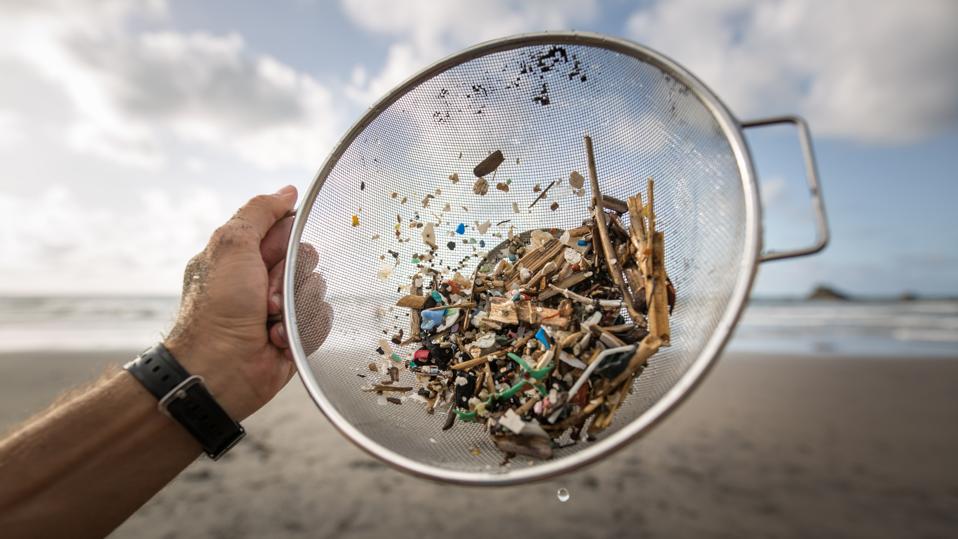Researchers from the University of New Mexico studying the presence of microplastics and nanoplastics in the body this month found the particles present in the testicles of every single dog and human test subject included in study of 70 participants, the latest piece of evidence showing that microscopic pieces of plastic have made their way into the human body through polluted food, water and air.

Key Takeaways
- Microplastics, defined as a piece of plastic less than 5 millimeters in length, are born from the disposal and breakdown of consumer products like single-use plastic bottles, food packages and plastic pellets, the tiny pieces of plastic used to make packaging, auto parts, toys and other items.
- As used plastic items are disposed of through ocean dumping and in landfills, microplastics make their way into human water sources via polluted runoff into lakes, rivers and estuaries, the World Health Organization explains, and they’re also launched into the atmosphere as bubbles containing of plastics burst at the ocean’s surface, researchers at Princeton found.
- People also ingest microplastics in more direct ways, often through food—thousands of tons of microplastics have made their way onto farmland and some have been absorbed by crops, Chinese scientists have found; Italian researchers discovered plastics in fish intended for human consumption; and containers, specifically those exposed to high temperatures, can leach microplastics into the food they hold, according to a study published in the Journal of Hazardous Materials.
- A study commissioned by the World Wildlife Fund suggested the average person ingests about 5 grams of plastic every week—about the weight of a credit card—and other research says the average person eats at least 50,000 particles of microplastic a year, a number that is thought to increase significantly for those with ultra-processed diets, the Guardian reported.
- Researchers in the Netherlands found microplastics in human blood for the first time in 2022 (scientists found particles in almost 80% of test subjects), Chinese scientists discovered them in the hearts of people undergoing cardiac surgery last year and, in a study published May 15, in they were found in the reproductive systems of men.
- The full long term impact of microplastics on human health are still largely unknown, but dozens of research studies have linked the particles to lung inflammation and a higher risk of lung cancer, metabolic disorders, neurotoxicity, endocrine disruption, weight gain, insulin resistance, and decreased reproductive health.
News Peg
The results of the recently released study that found particles in the testes of humans and dogs came as a shock to researchers. John Yu, the study’s lead author, told NPR he didn’t expect the plastics to be so prevalent in the male reproductive system and suggested the result could be connected to the global decline in male fertility, particularly sperm count. Tracey Woodruff, director of the Environmental Research and Translation for Health Center, called the research “a wake up call for policymakers.”
Key Background
The first study of plastic debris found in the ocean was published in 1972 when scientists found small plastic particles in the middle of the Atlantic, according to Oceanography magazine. Researchers began tracking plastic debris via surface trawls and study began in earnest after the discovery of the “Great Pacific Garbage Patch”—the largest accumulation of plastic in the open ocean—in 1996. Over the last 20 years, increased discovery combined with public awareness campaigns have pushed the issue of ocean pollution to the forefront, and researchers in 2012 made the discovery that the majority of plastic pollution consisted of tiny, often invisible pieces of microplastics. Since then, scientists have committed research to where microplastics come from, how they travel, how they infiltrate living things and how they impact ecosystems, according to Oceanography.
Crucial Quote
“Our work has so clearly shown that microplastics are present in every sample of beach sand, whether it’s in Australia, Asia, Europe, North or South America,” Richard Thompson, professor of Marine Biology and Director of the University’s Marine Institute, wrote. “We’ve looked in the deep sea, in Arctic ice, in the gut of hundreds of fish from the English Channel and we’ve found microplastic contamination everywhere.”
Big Number
400 million tons. That’s how much plastic waste is produced every year, according to the United Nations.
Surprising Fact
Petrochemical companies bear the most fault for single-use plastic waste, according to a study published in 2020 and reported by CNBC. More than half of the world’s single-use plastic waste comes from 20 petrochemical companies, the study said, with ExxonMobil named the biggest offender. Ninety percent of single-use plastic is produced by just 100 companies.


